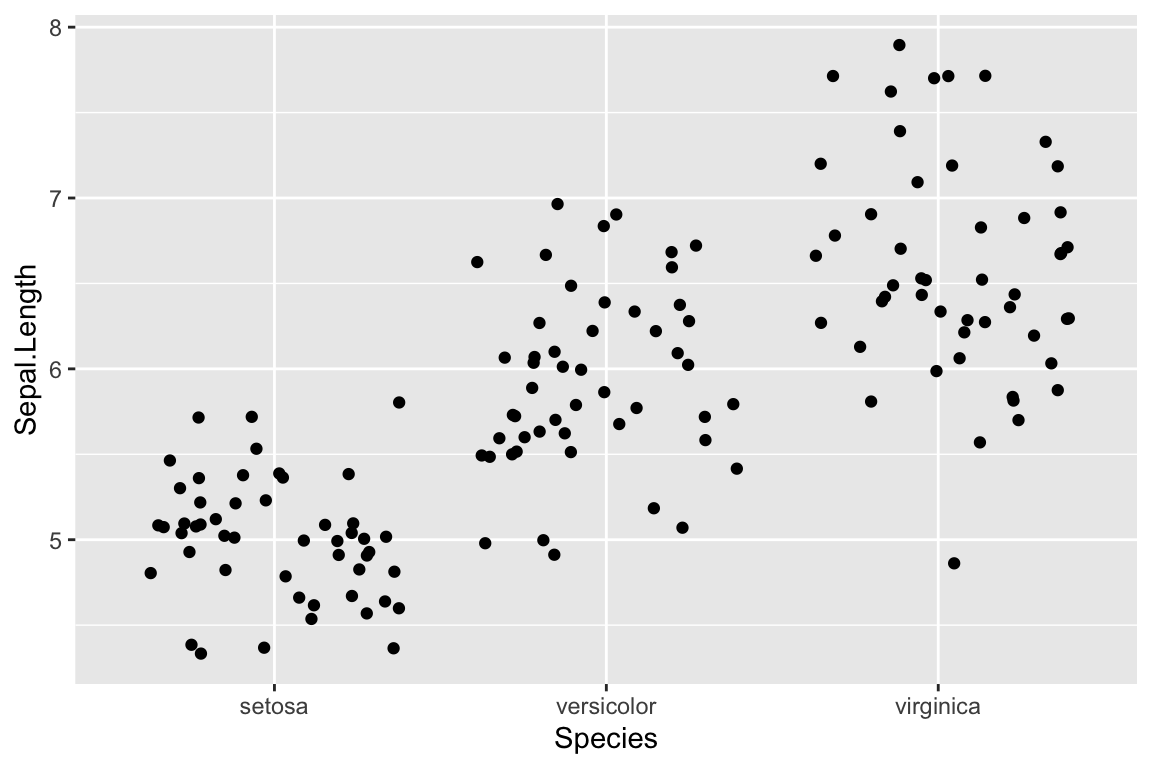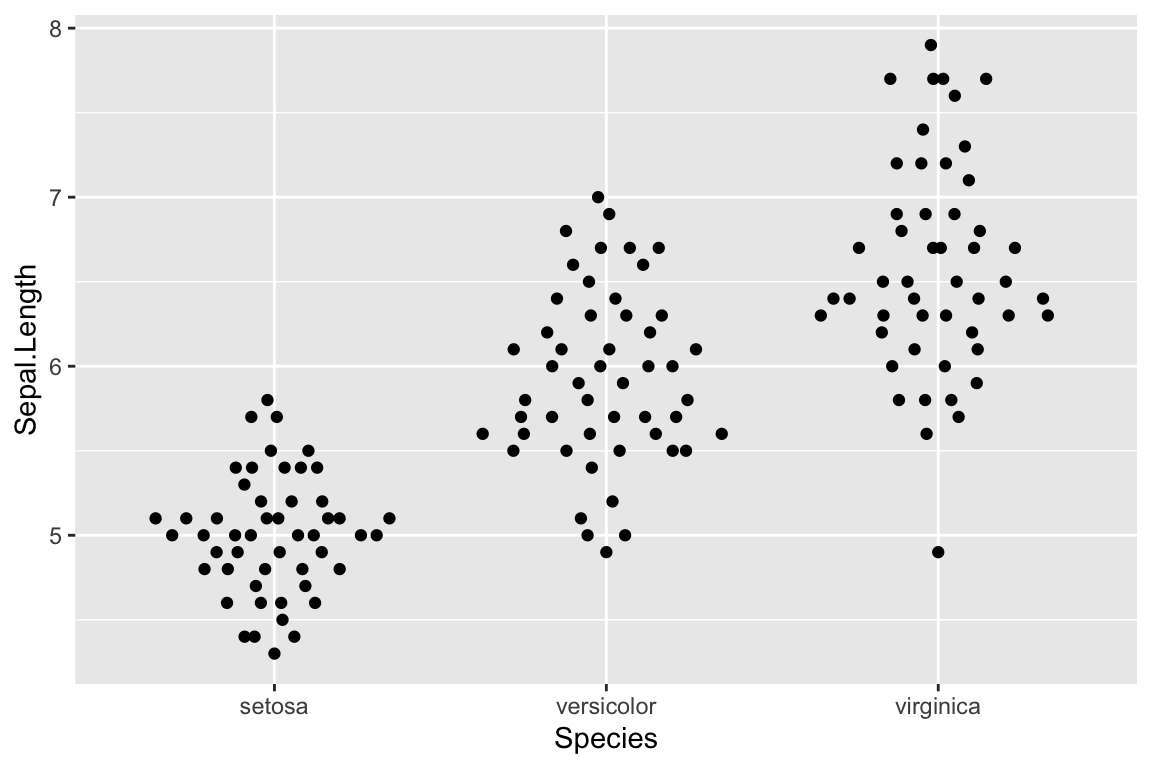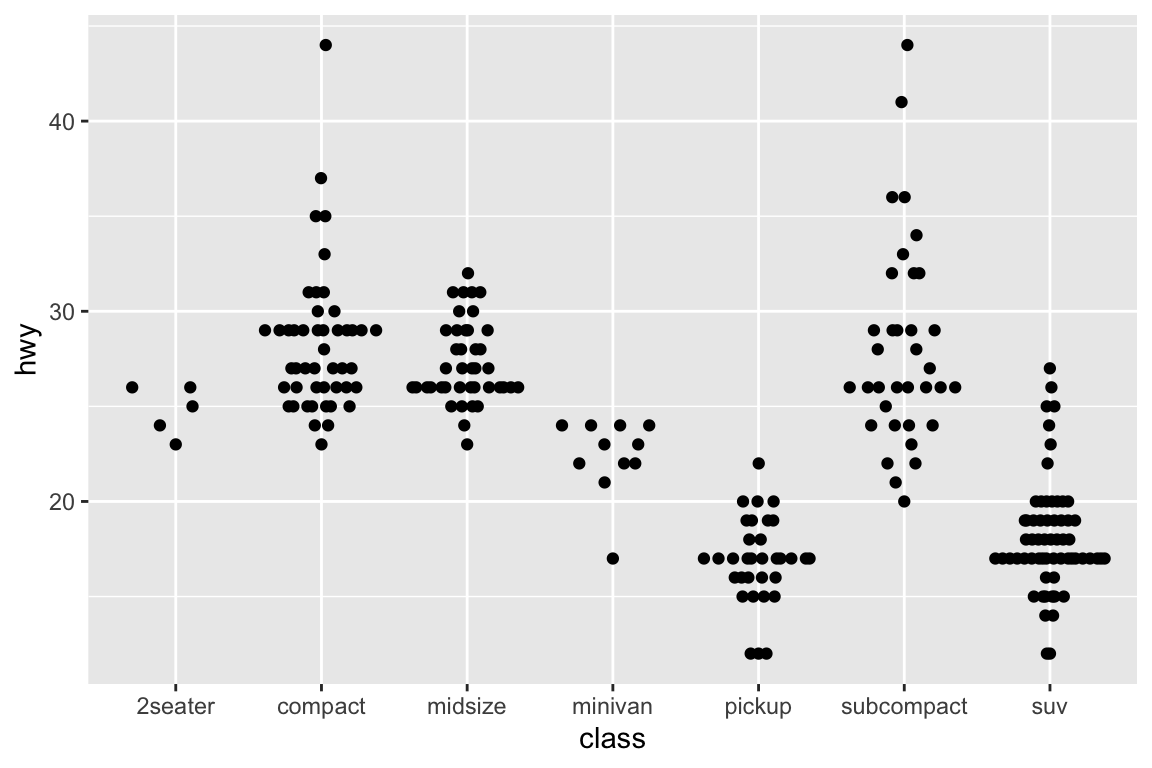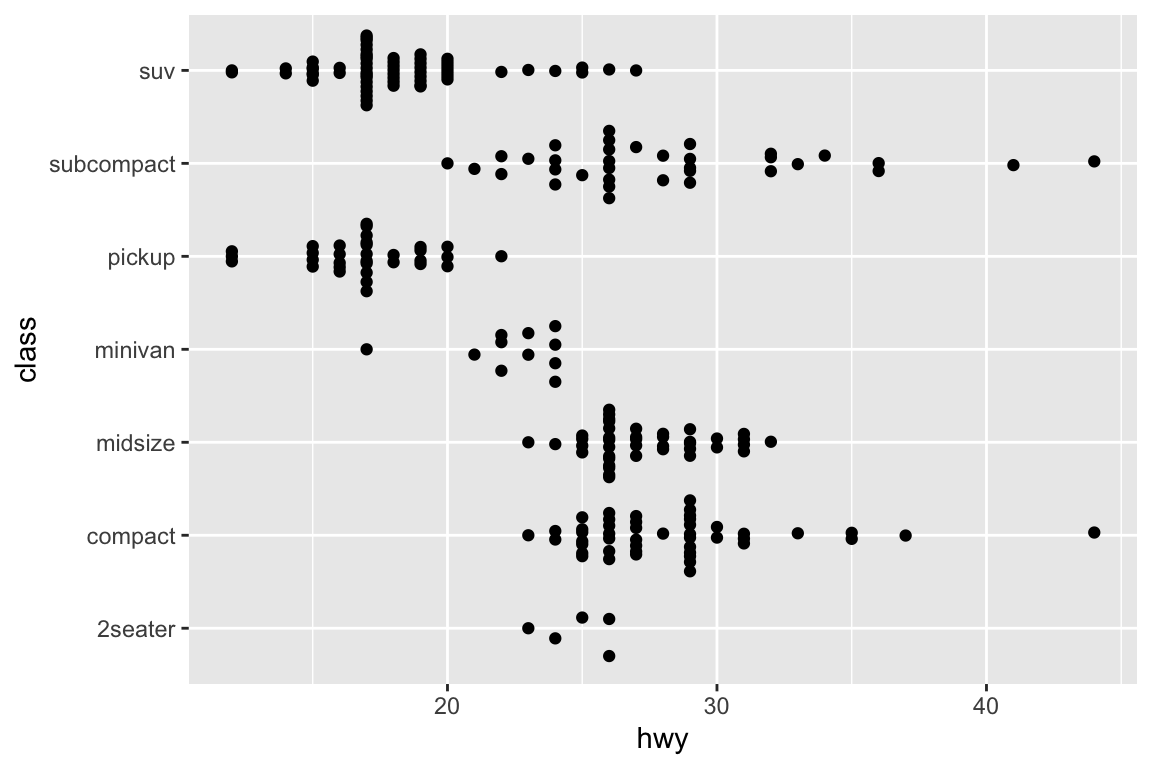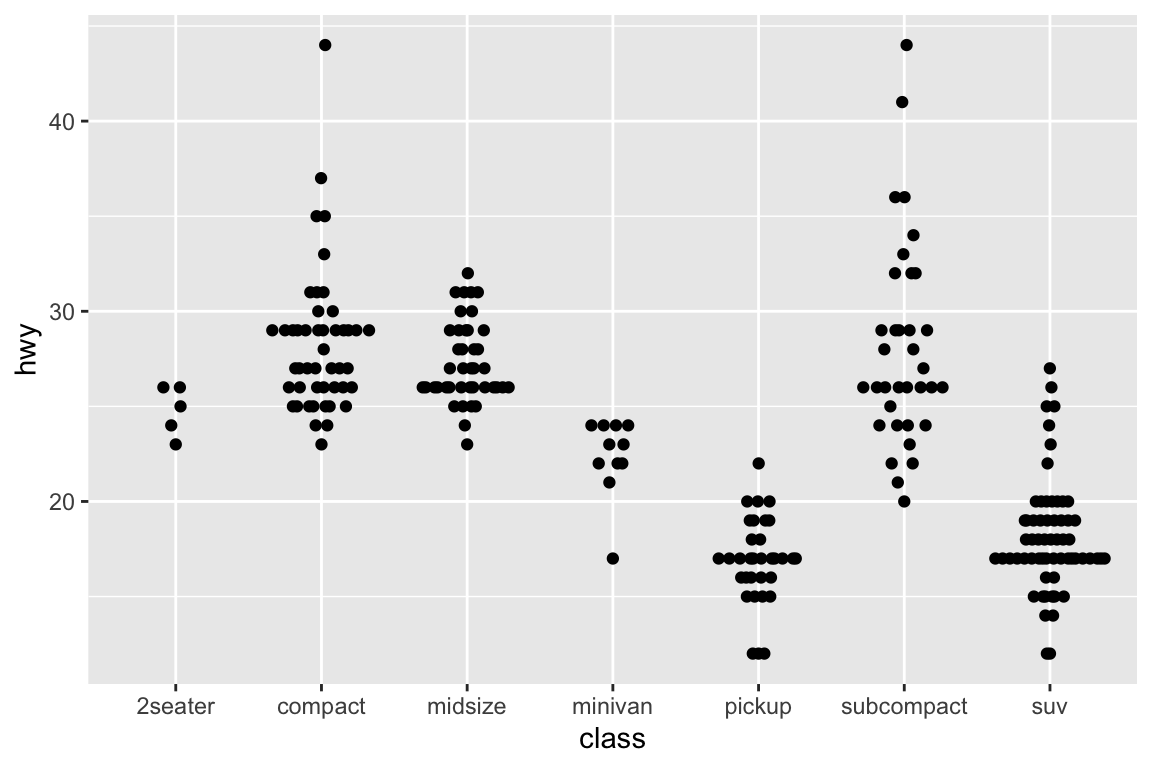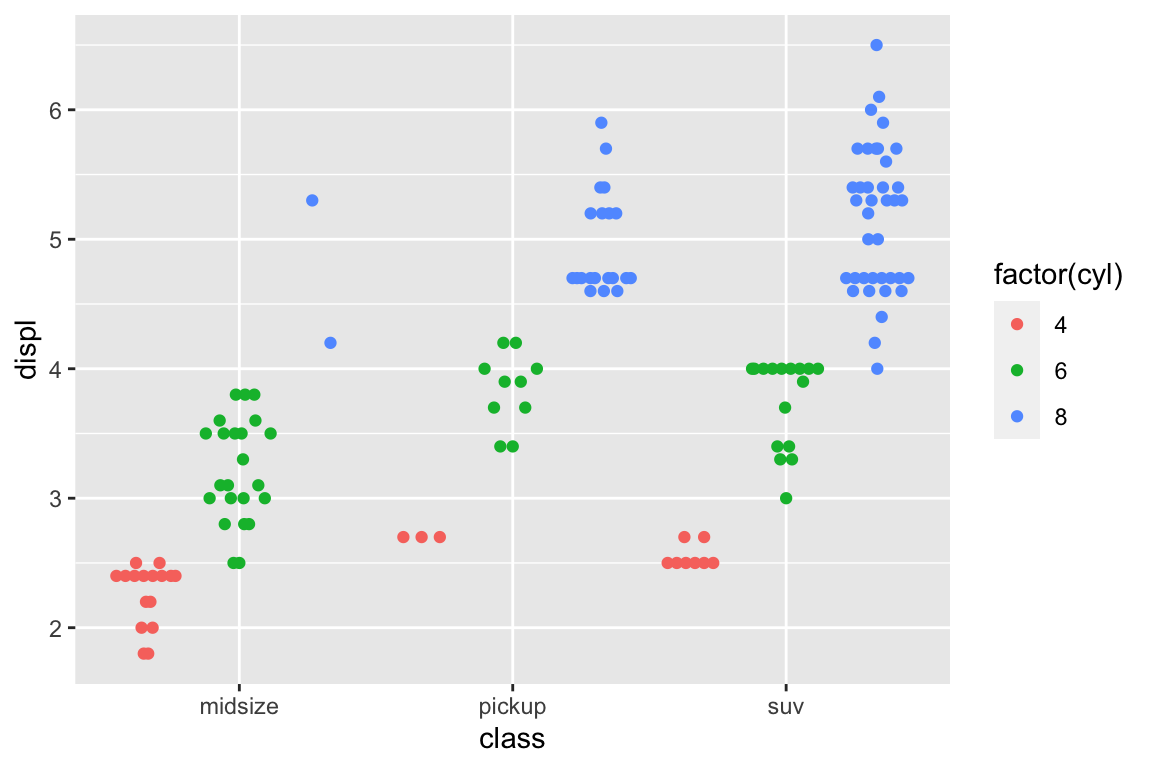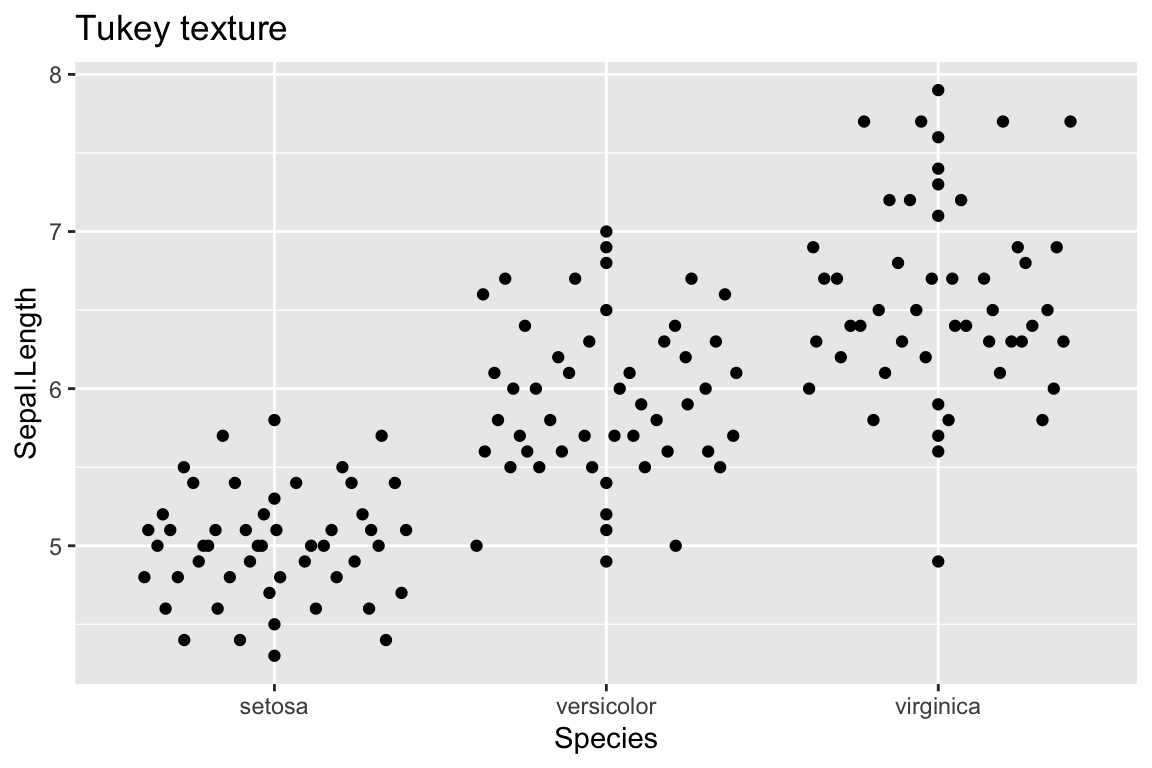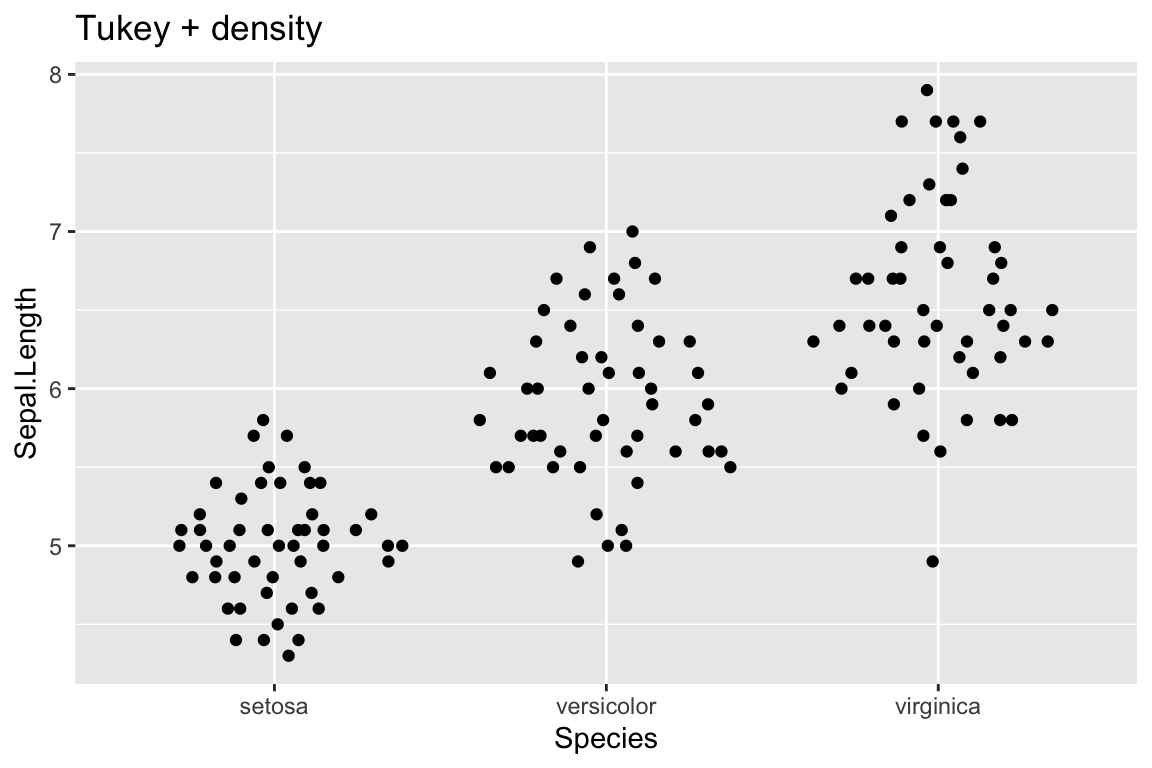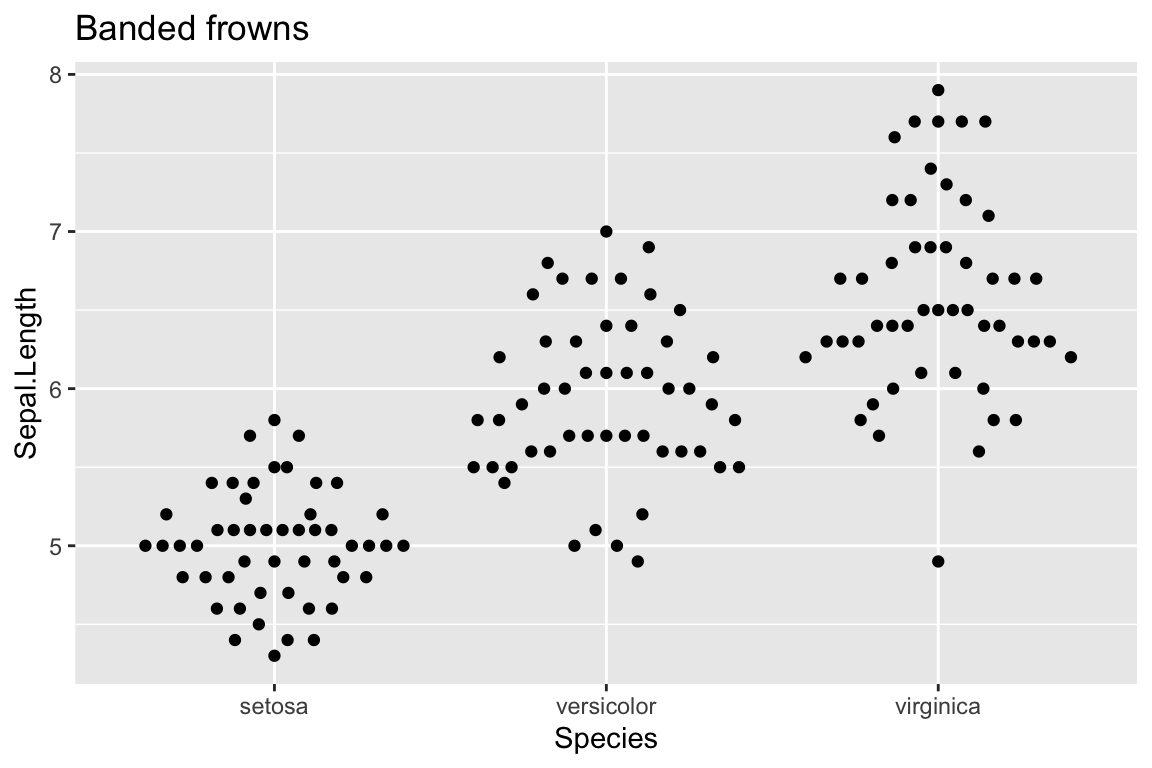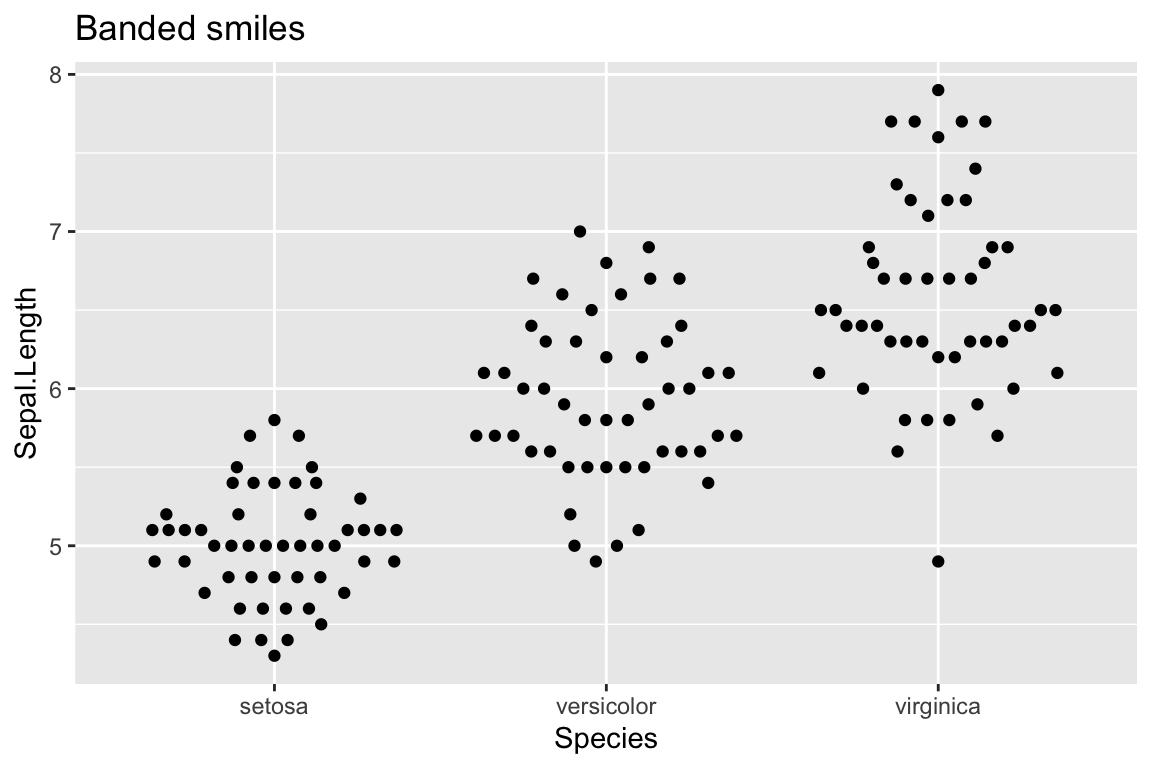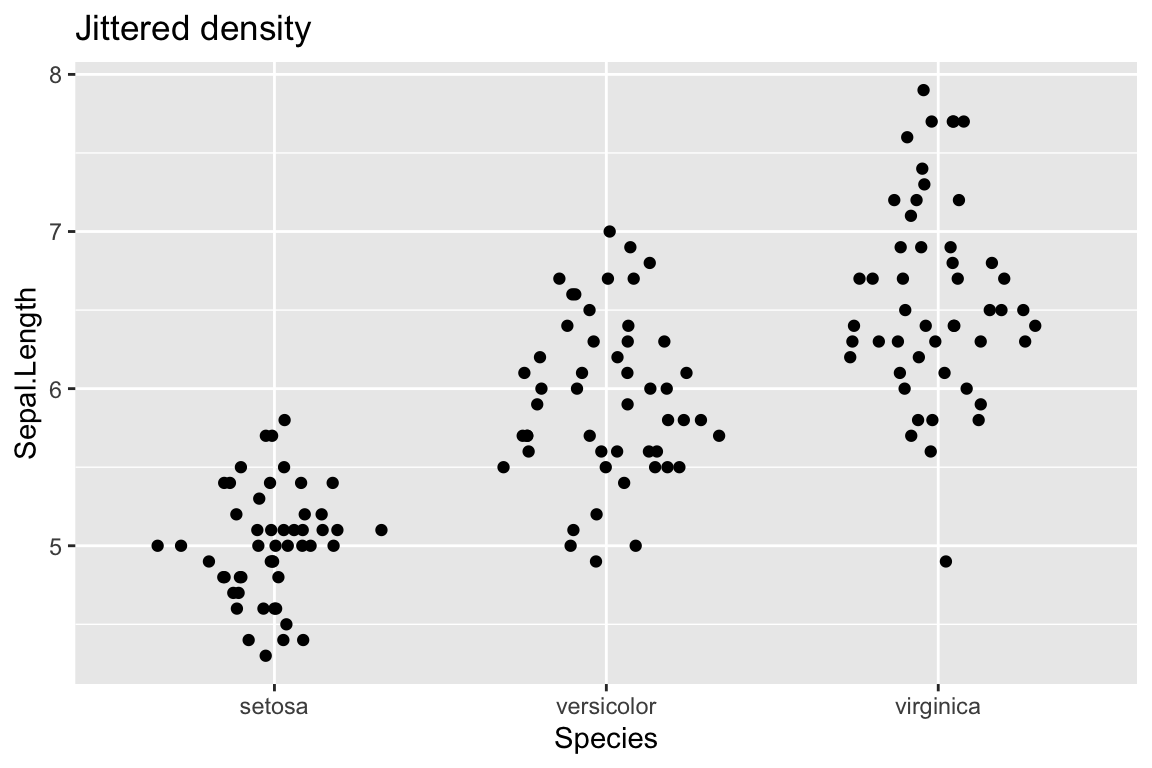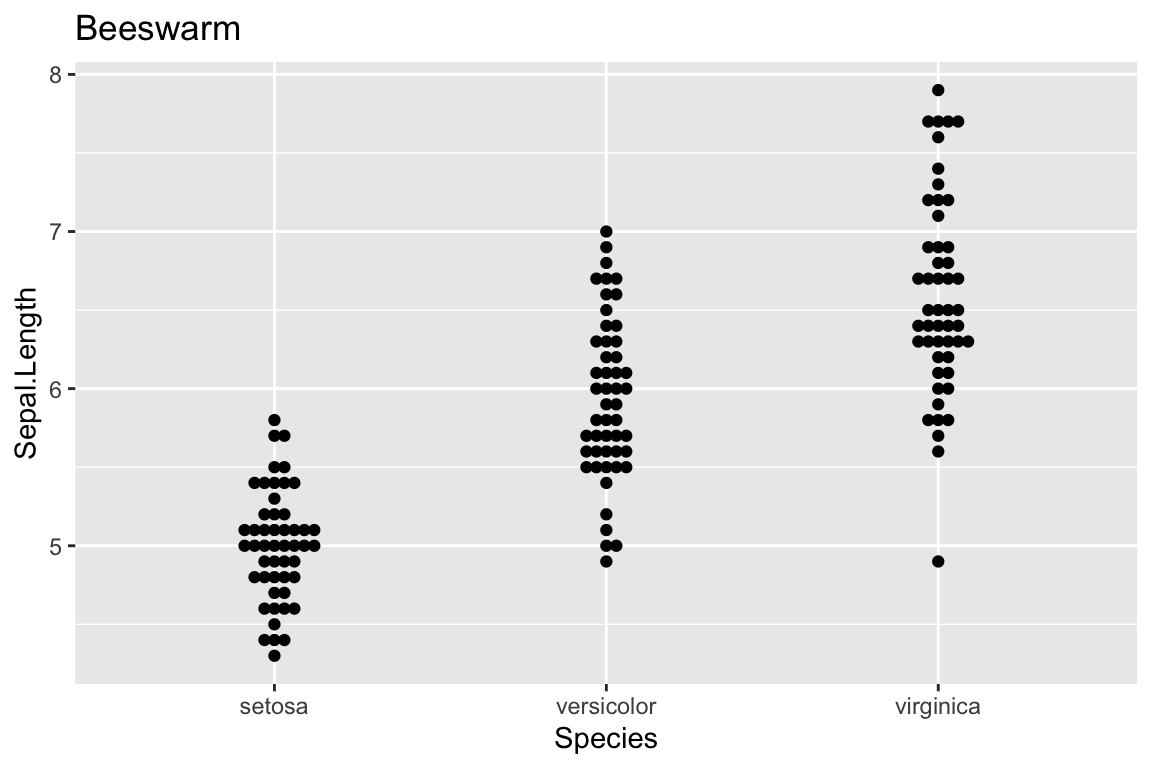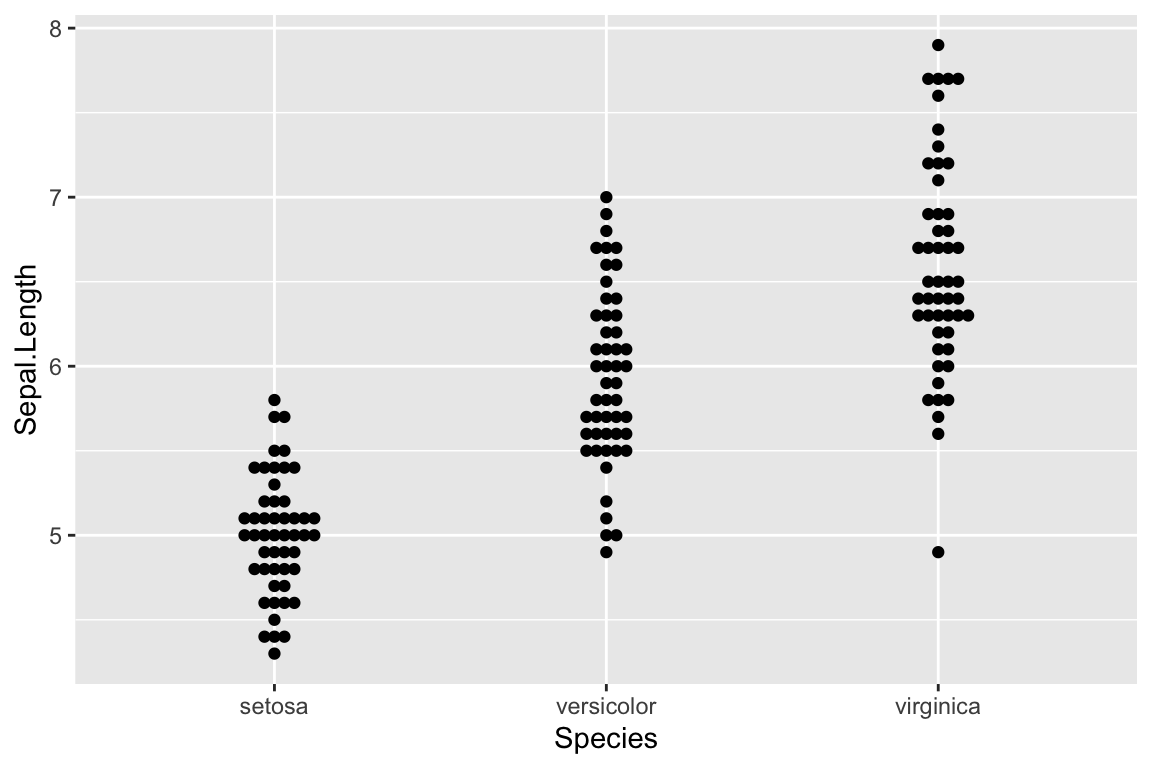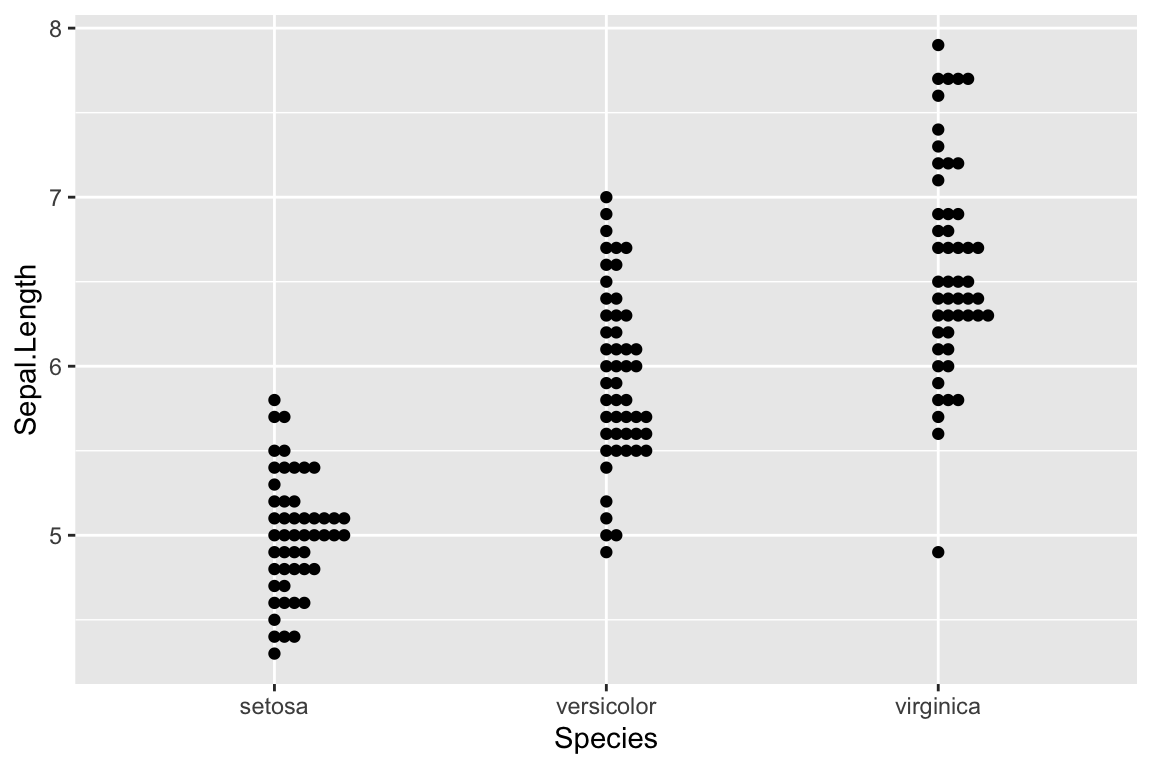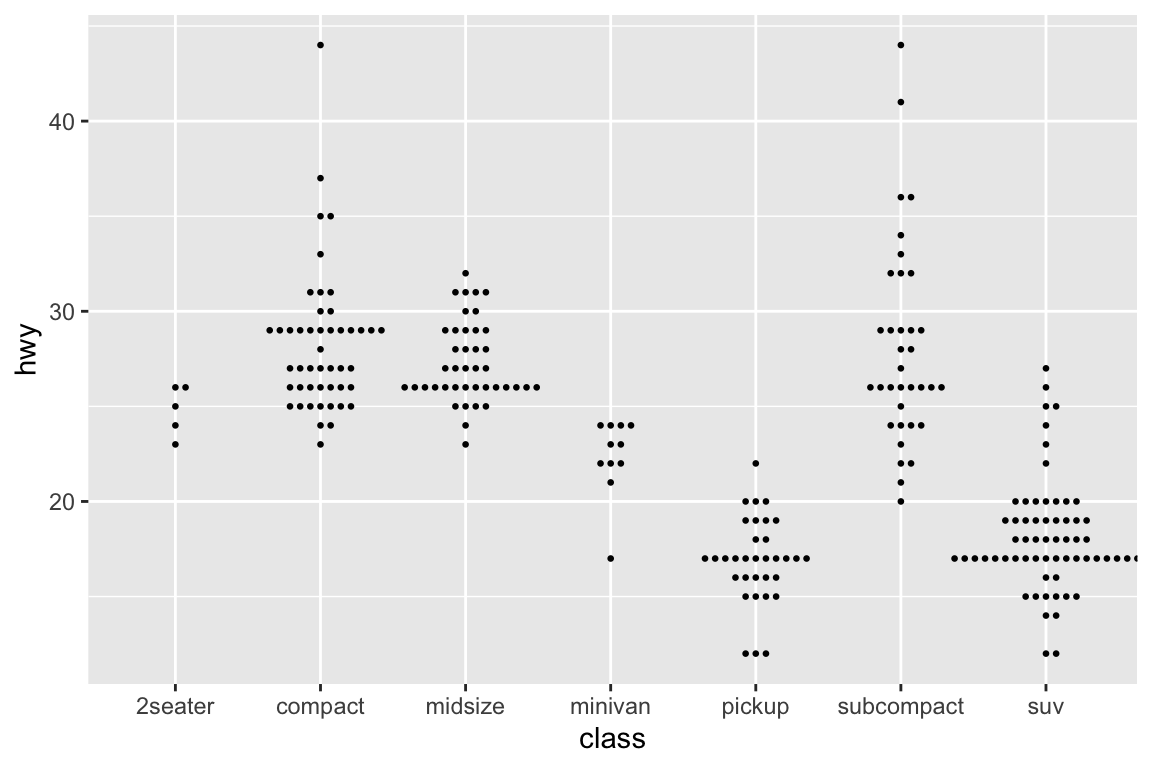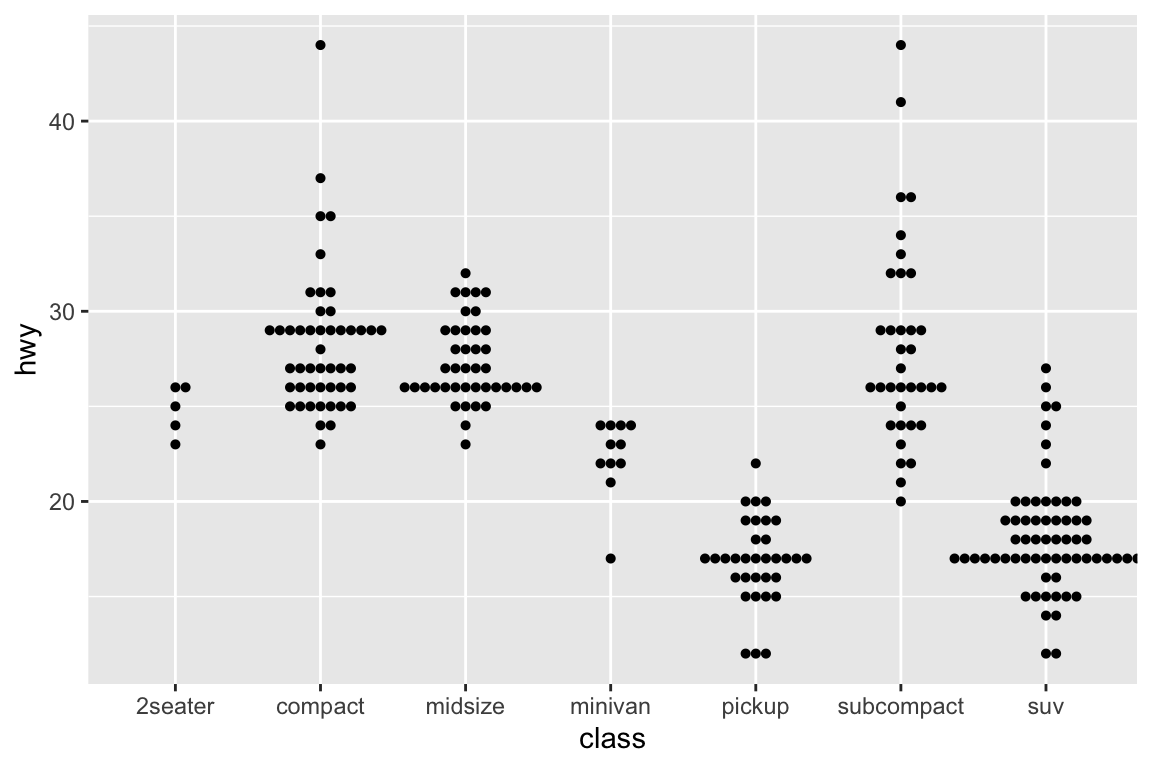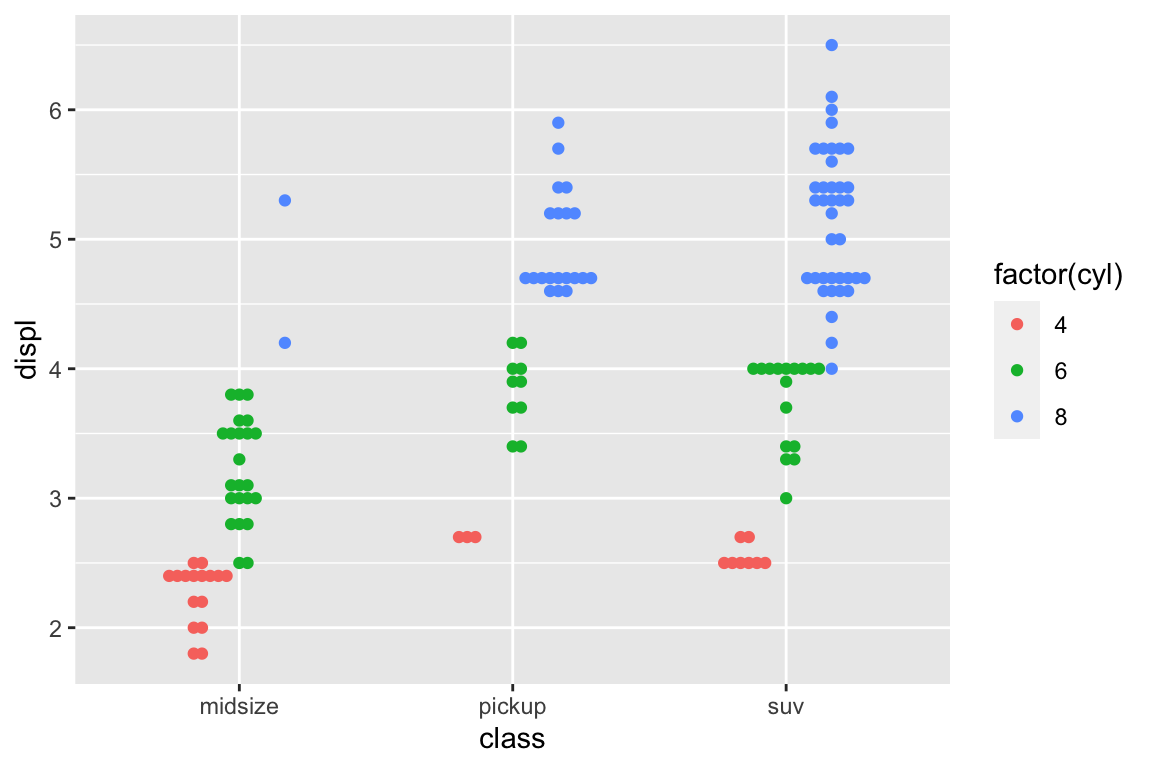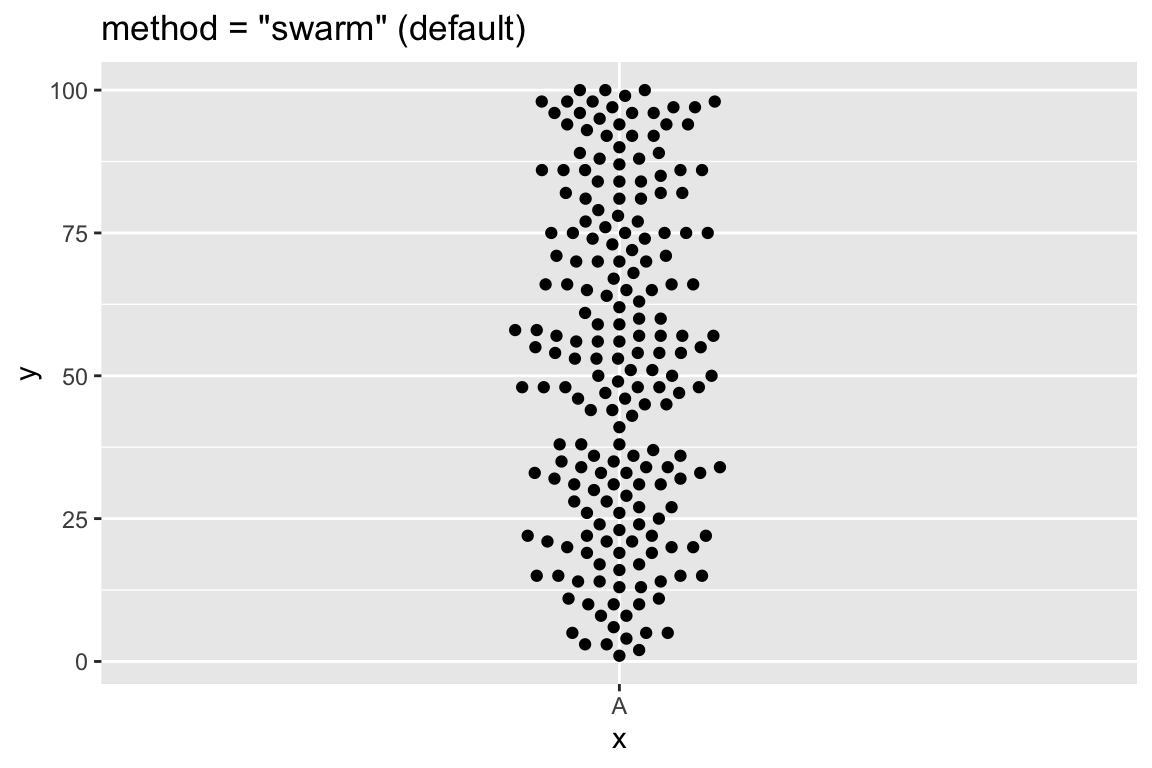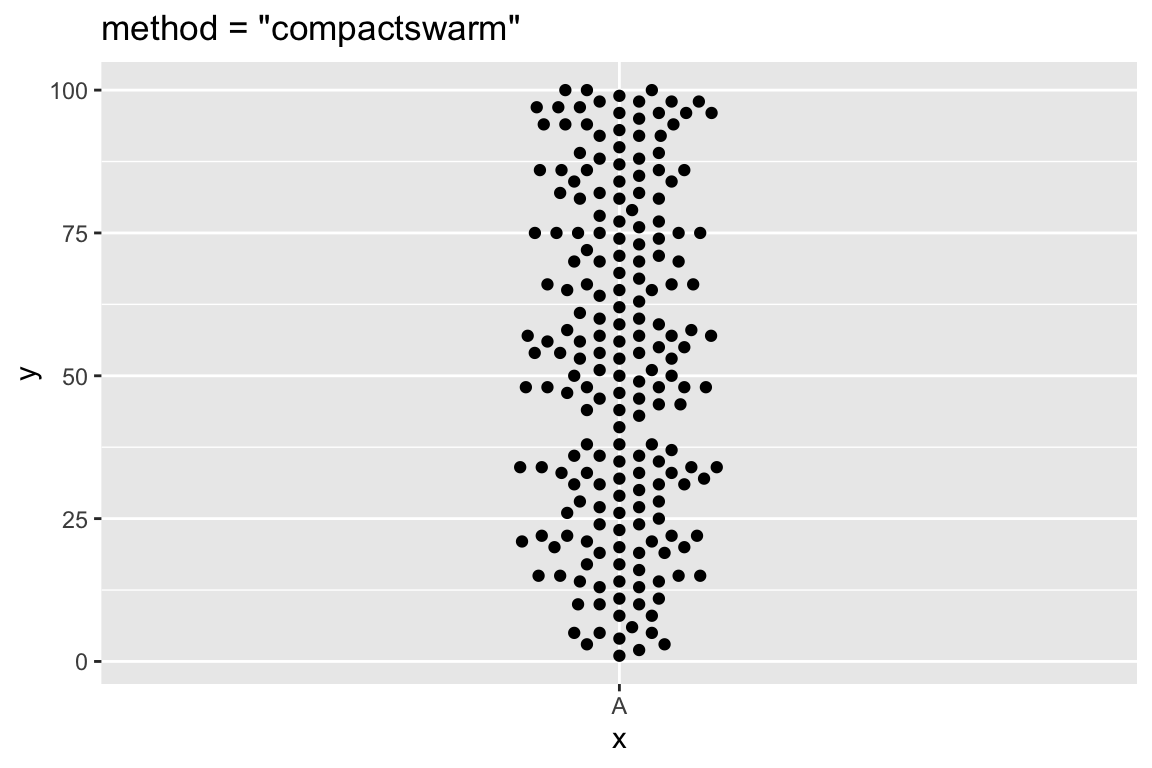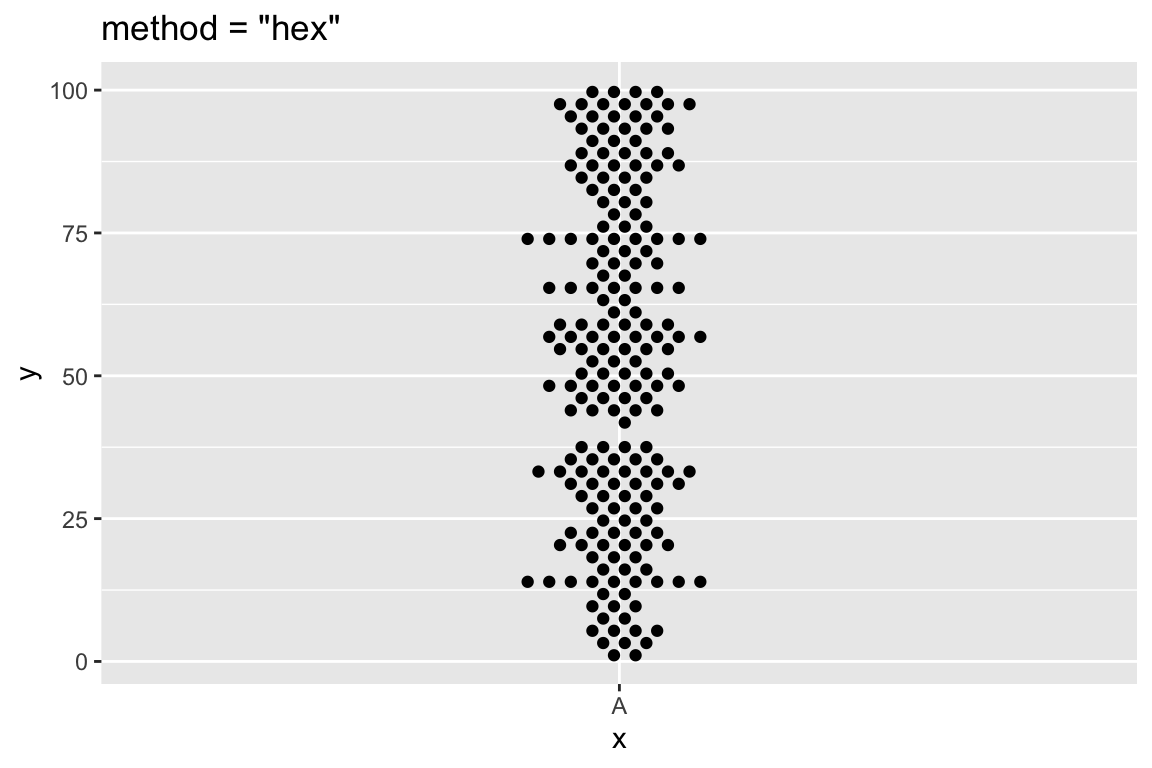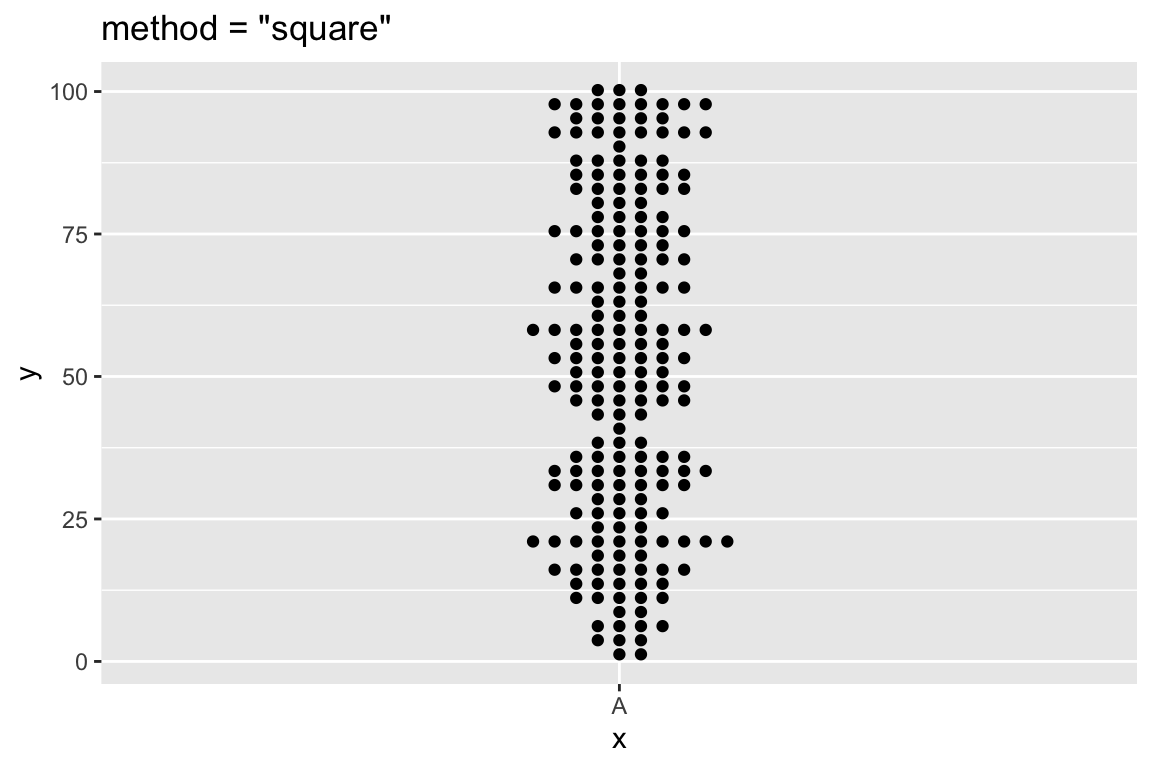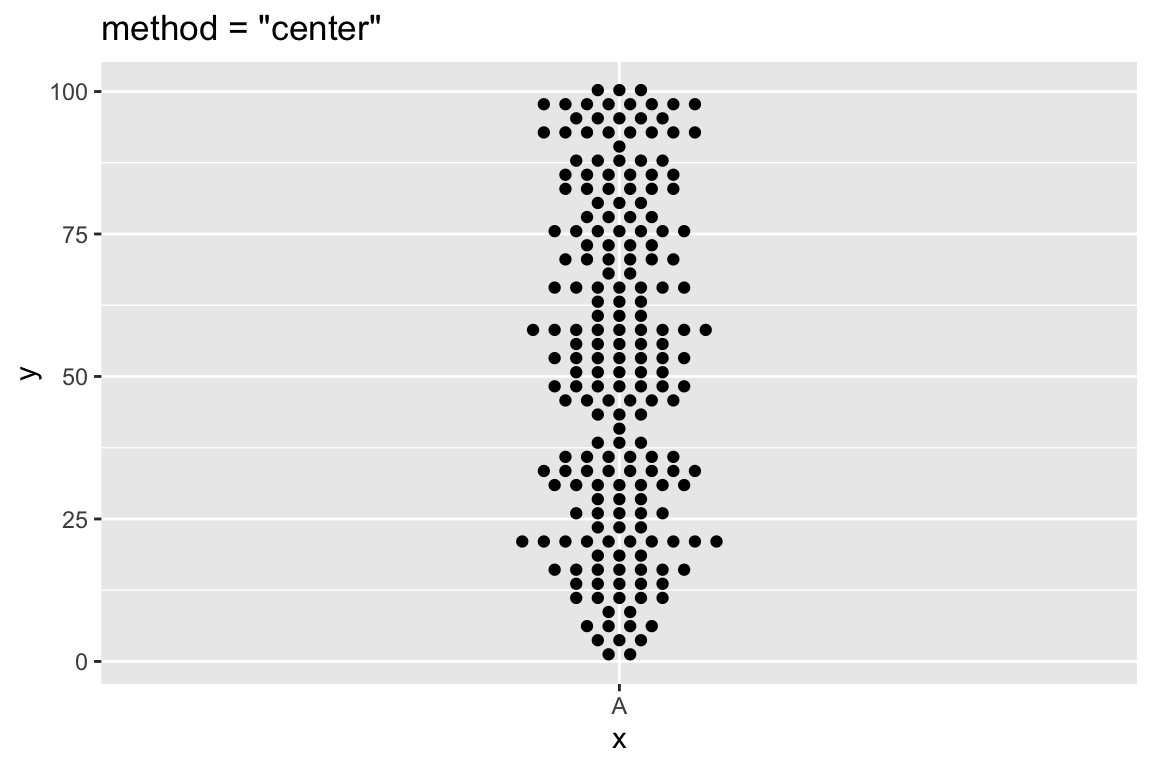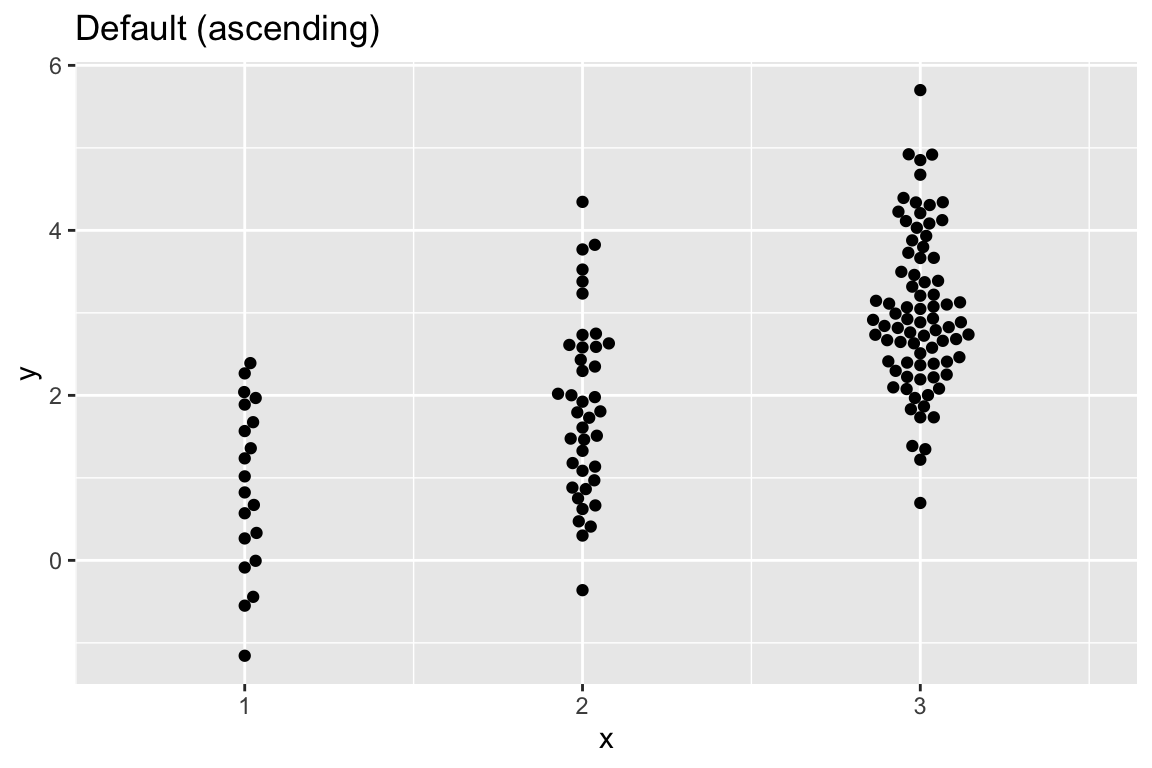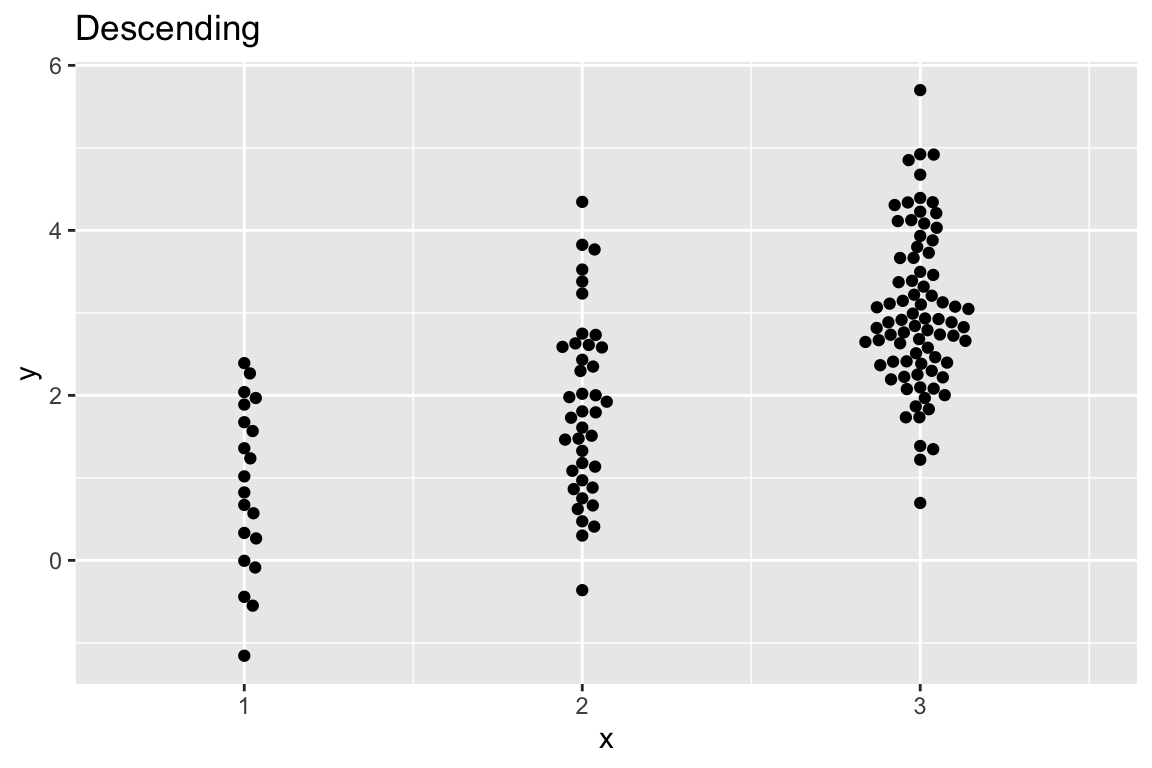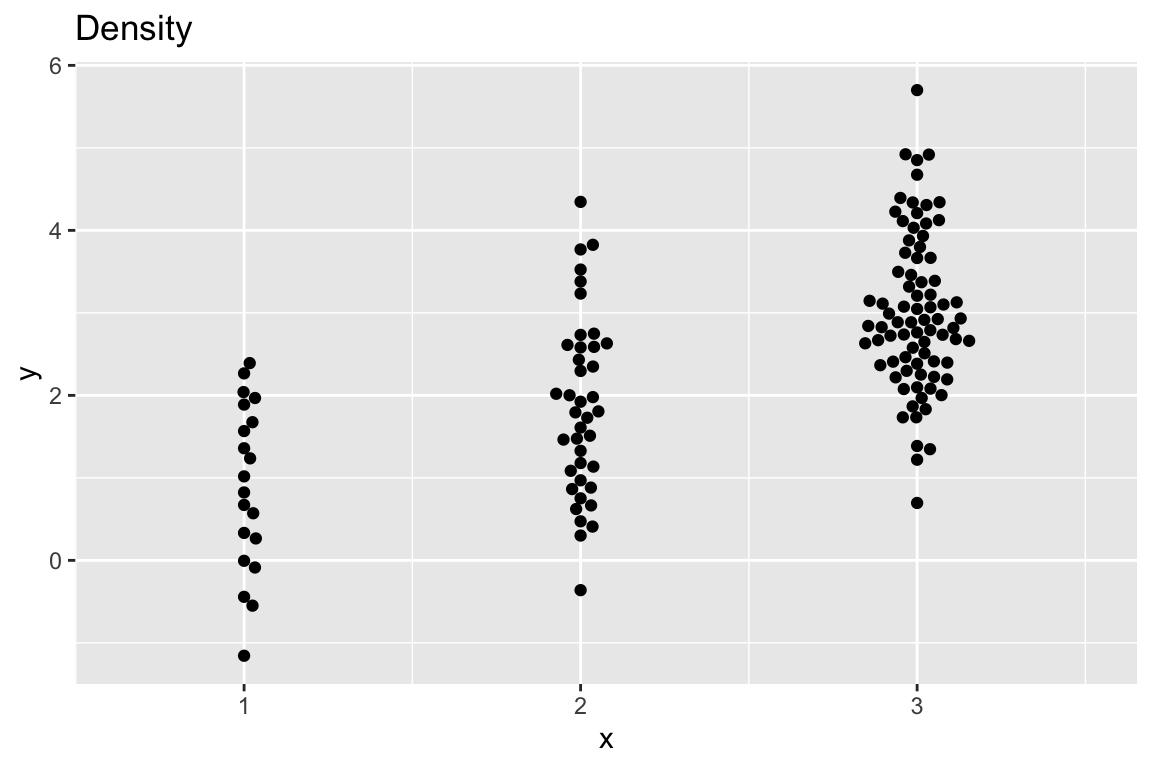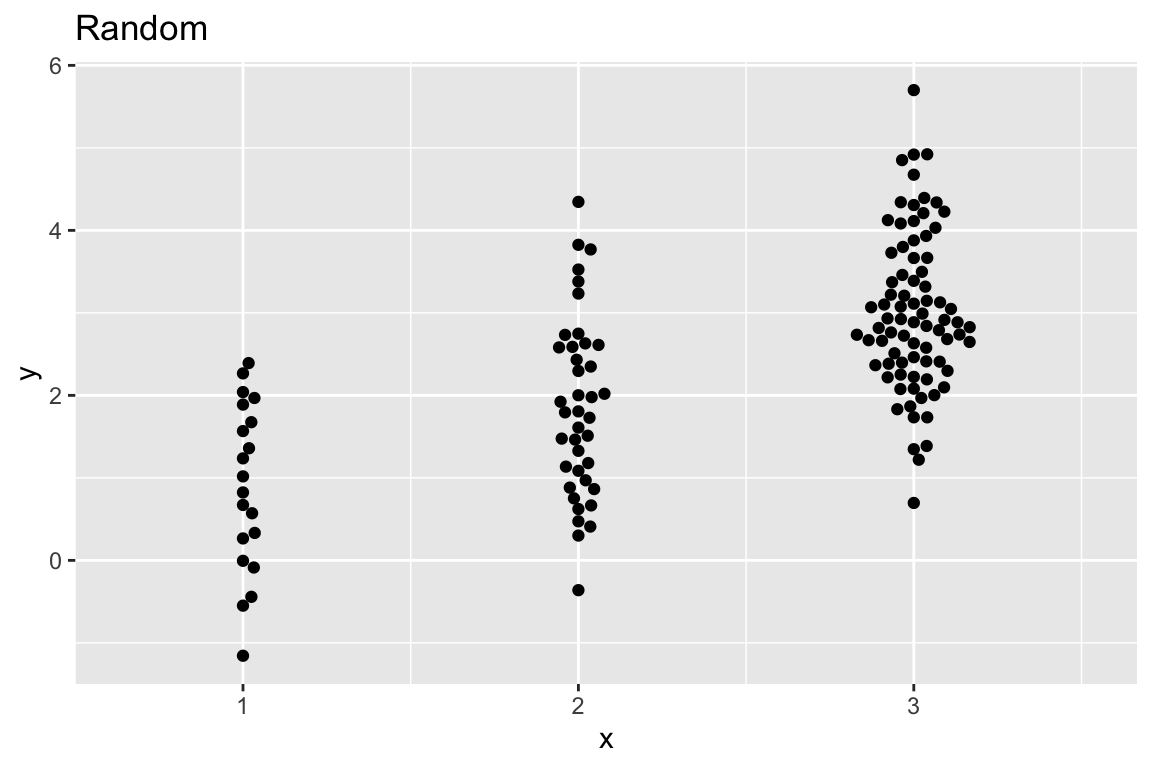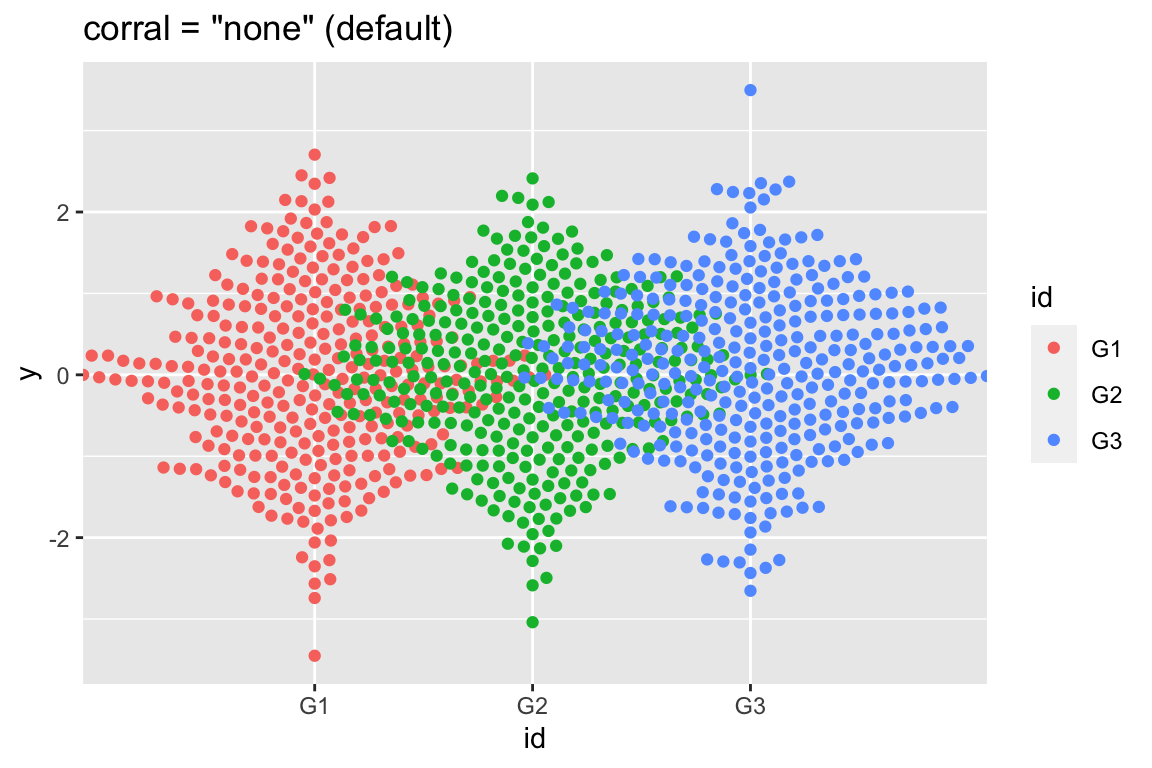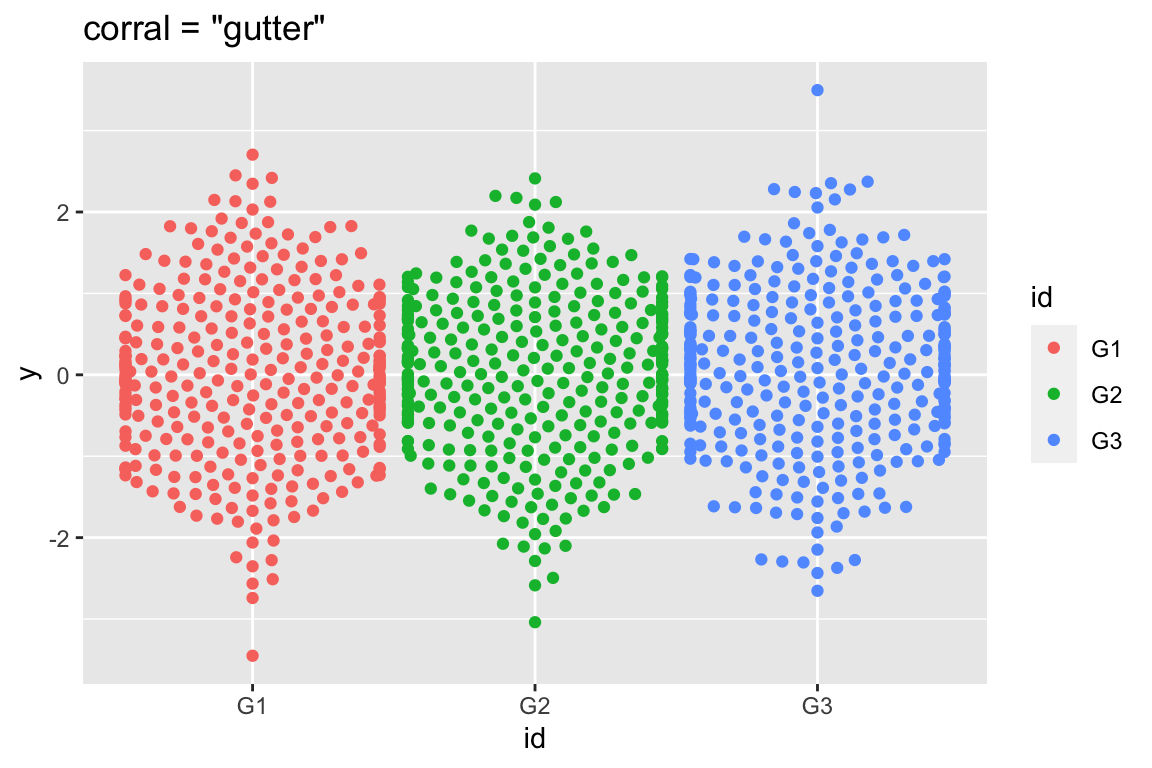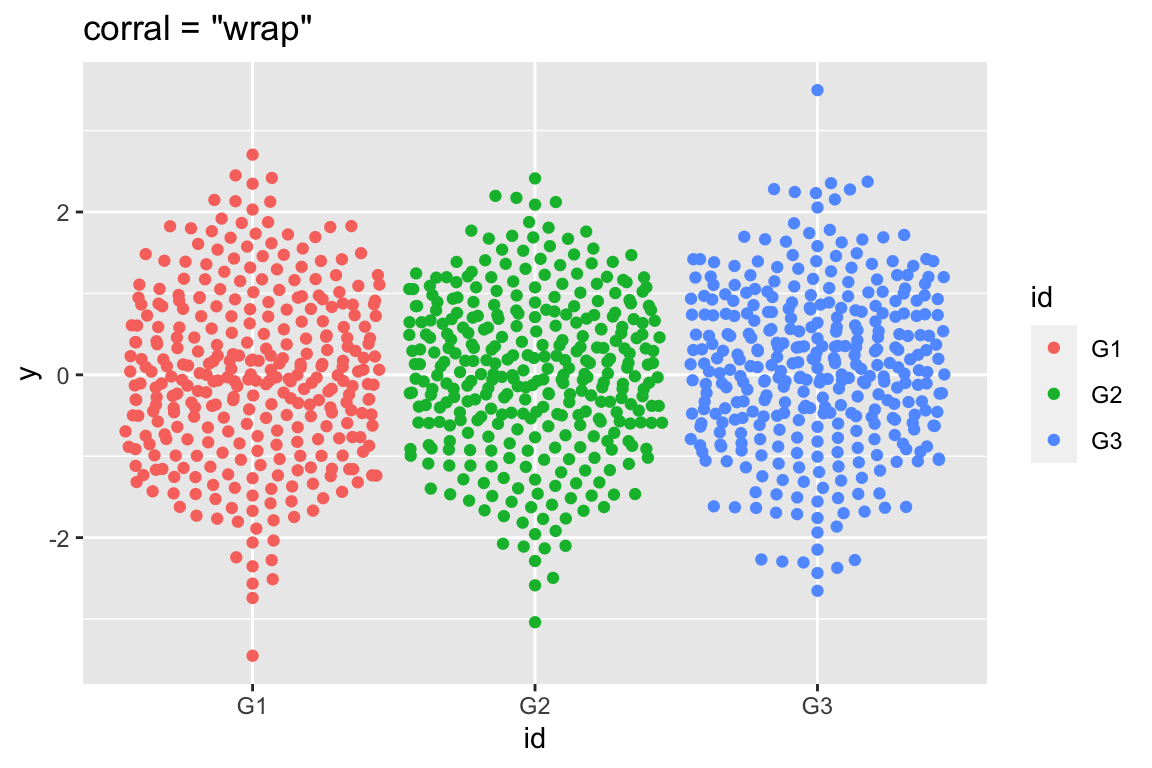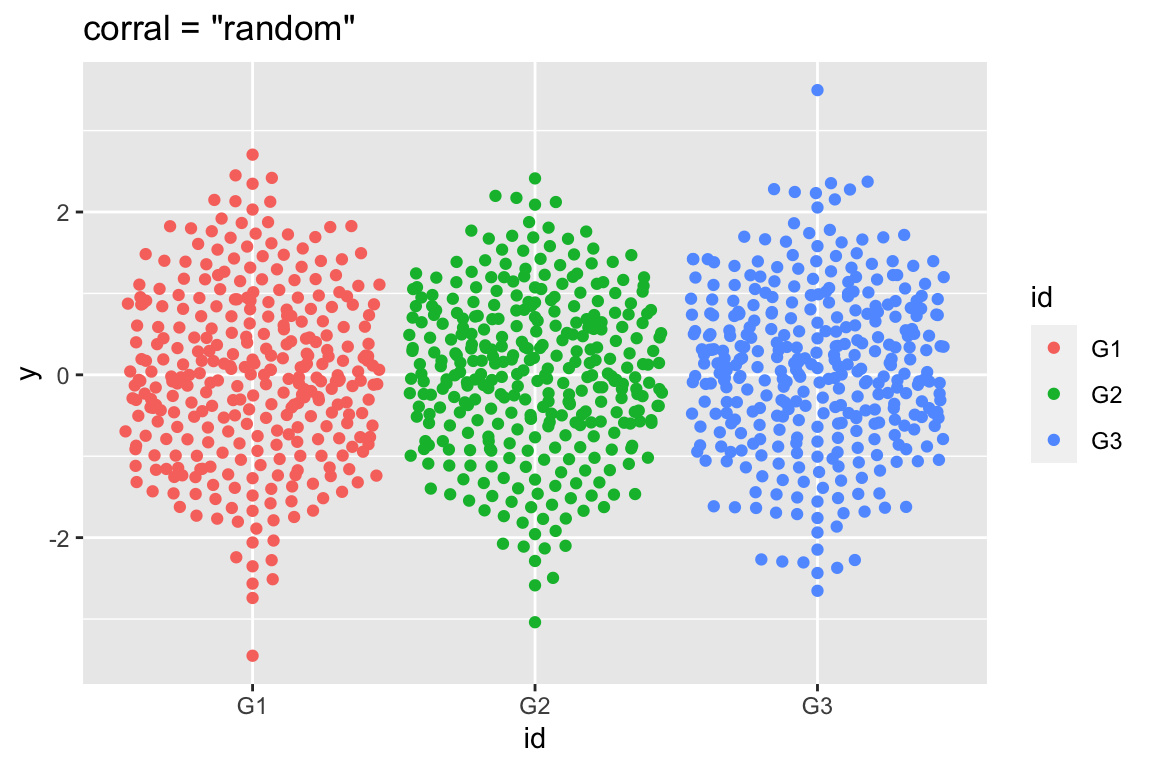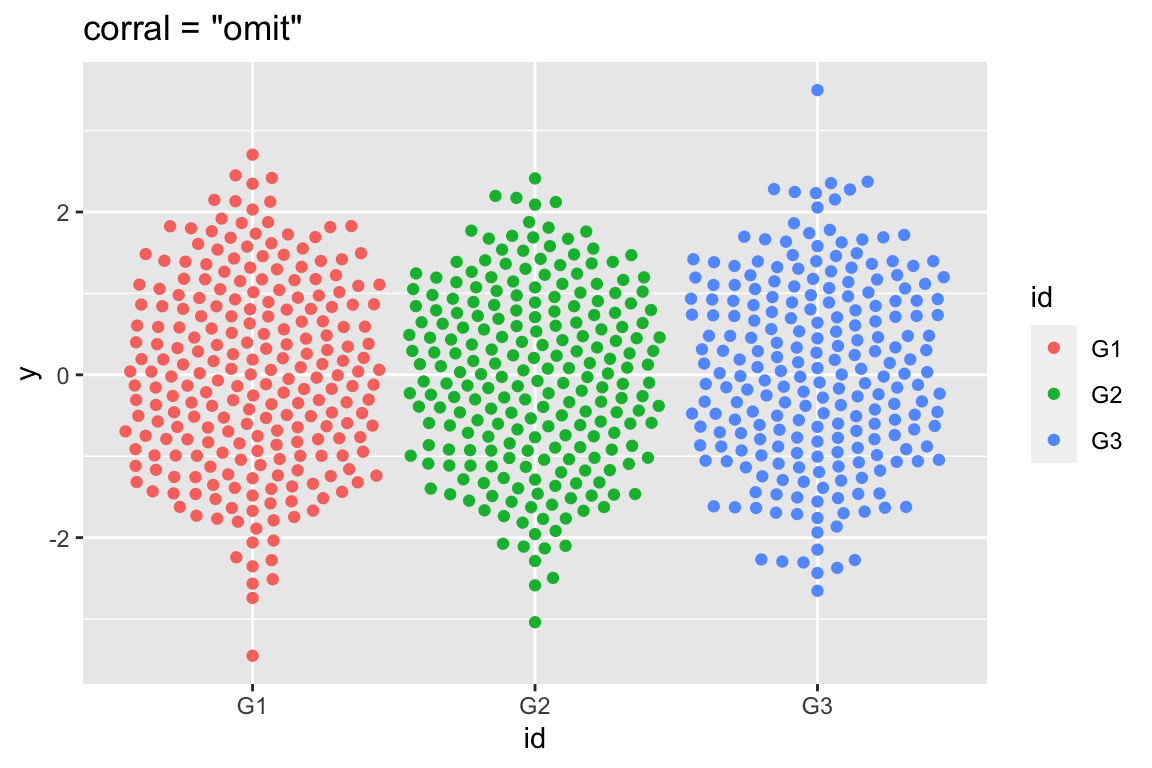Beeswarm-style plots with ggplot2
Introduction
Beeswarm plots (aka column scatter plots or violin scatter plots) are a way of plotting points that would ordinarily overlap so that they fall next to each other instead. In addition to reducing overplotting, it helps visualize the density of the data at each point (similar to a violin plot), while still showing each data point individually.
ggbeeswarm provides two different methods to create beeswarm-style
plots using ggplot2. It does this by adding two
new ggplot geom objects:
-
geom_quasirandom: Uses a van der Corput sequence or Tukey texturing (Tukey and Tukey “Strips displaying empirical distributions: I. textured dot strips”) to space the dots to avoid overplotting. This uses sherrillmix/vipor. -
geom_beeswarm: Uses the beeswarm library to do point-size based offset.
Features:
- Can handle categorical variables on the y-axis (thanks @smsaladi, @koncina)
- Automatically dodges if a grouping variable is categorical and
dodge.widthis specified (thanks @josesho)
See the examples below.
Installation
This package is on CRAN so install should be a simple:
install.packages('ggbeeswarm')If you want the development version from GitHub, you can do:
devtools::install_github("eclarke/ggbeeswarm")Examples
Here is a comparison between geom_jitter and geom_quasirandom on the
iris dataset:
set.seed(12345)
library(ggplot2)
library(ggbeeswarm)
#compare to jitter
ggplot(iris,aes(Species, Sepal.Length)) + geom_jitter()ggplot(iris,aes(Species, Sepal.Length)) + geom_quasirandom()geom_quasirandom()
Using geom_quasirandom:
#default geom_quasirandom
ggplot(mpg,aes(class, hwy)) + geom_quasirandom()# With categorical y-axis
ggplot(mpg,aes(hwy, class)) + geom_quasirandom(groupOnX=FALSE)# Some groups may have only a few points. Use `varwidth=TRUE` to adjust width dynamically.
ggplot(mpg,aes(class, hwy)) + geom_quasirandom(varwidth = TRUE)# Automatic dodging
sub_mpg <- mpg[mpg$class %in% c("midsize", "pickup", "suv"),]
ggplot(sub_mpg, aes(class, displ, color=factor(cyl))) + geom_quasirandom(dodge.width=1)Alternative methods
geom_quasirandom can also use several other methods to distribute
points. For example:
ggplot(iris, aes(Species, Sepal.Length)) + geom_quasirandom(method = "tukey") + ggtitle("Tukey texture")ggplot(iris, aes(Species, Sepal.Length)) + geom_quasirandom(method = "tukeyDense") +
ggtitle("Tukey + density")ggplot(iris, aes(Species, Sepal.Length)) + geom_quasirandom(method = "frowney") +
ggtitle("Banded frowns")ggplot(iris, aes(Species, Sepal.Length)) + geom_quasirandom(method = "smiley") +
ggtitle("Banded smiles")ggplot(iris, aes(Species, Sepal.Length)) + geom_quasirandom(method = "pseudorandom") +
ggtitle("Jittered density")ggplot(iris, aes(Species, Sepal.Length)) + geom_beeswarm() + ggtitle("Beeswarm")geom_beeswarm()
Using geom_beeswarm:
ggplot(iris,aes(Species, Sepal.Length)) + geom_beeswarm()ggplot(iris,aes(Species, Sepal.Length)) + geom_beeswarm(side = 1L)ggplot(mpg,aes(class, hwy)) + geom_beeswarm(size=.5)# With categorical y-axis
ggplot(mpg,aes(hwy, class)) + geom_beeswarm(size=.5)# Also watch out for points escaping from the plot with geom_beeswarm
ggplot(mpg,aes(hwy, class)) + geom_beeswarm(size=.5) + scale_y_discrete(expand=expansion(add=c(0.5,1)))ggplot(mpg,aes(class, hwy)) + geom_beeswarm(size=1.1)# With automatic dodging
ggplot(sub_mpg, aes(class, displ, color=factor(cyl))) + geom_beeswarm(dodge.width=0.5)Alternative methods
df <- data.frame(
x = "A",
y = sample(1:100, 200, replace = TRUE)
)
ggplot(df, aes(x = x, y = y)) + geom_beeswarm(cex = 2.5, method = "swarm") + ggtitle('method = "swarm" (default)')ggplot(df, aes(x = x, y = y)) + geom_beeswarm(cex = 2.5, method = "compactswarm") + ggtitle('method = "compactswarm"')ggplot(df, aes(x = x, y = y)) + geom_beeswarm(cex = 2.5, method = "hex") + ggtitle('method = "hex"')ggplot(df, aes(x = x, y = y)) + geom_beeswarm(cex = 2.5, method = "square") + ggtitle('method = "square"')ggplot(df, aes(x = x, y = y)) + geom_beeswarm(cex = 2.5, method = "center") + ggtitle('method = "center"')Different point distribution priority
#With different beeswarm point distribution priority
dat<-data.frame(x=rep(1:3,c(20,40,80)))
dat$y<-rnorm(nrow(dat),dat$x)
ggplot(dat,aes(x,y)) + geom_beeswarm(cex=2) + ggtitle('Default (ascending)') + scale_x_continuous(expand=expansion(add=c(0.5,.5)))ggplot(dat,aes(x,y)) + geom_beeswarm(cex=2,priority='descending') + ggtitle('Descending') + scale_x_continuous(expand=expansion(add=c(0.5,.5)))ggplot(dat,aes(x,y)) + geom_beeswarm(cex=2,priority='density') + ggtitle('Density') + scale_x_continuous(expand=expansion(add=c(0.5,.5)))ggplot(dat,aes(x,y)) + geom_beeswarm(cex=2,priority='random') + ggtitle('Random') + scale_x_continuous(expand=expansion(add=c(0.5,.5)))Corral runaway points
set.seed(1995)
df2 <- data.frame(
y = rnorm(1000),
id = sample(c("G1", "G2", "G3"), size = 1000, replace = TRUE)
)
p <- ggplot(df2, aes(x = id, y = y, colour = id))
# use corral.width to control corral width
p + geom_beeswarm(cex = 2.5, corral = "none", corral.width = 0.9) + ggtitle('corral = "none" (default)')p + geom_beeswarm(cex = 2.5, corral = "gutter", corral.width = 0.9) + ggtitle('corral = "gutter"')p + geom_beeswarm(cex = 2.5, corral = "wrap", corral.width = 0.9) + ggtitle('corral = "wrap"')p + geom_beeswarm(cex = 2.5, corral = "random", corral.width = 0.9) + ggtitle('corral = "random"')p + geom_beeswarm(cex = 2.5, corral = "omit", corral.width = 0.9) + ggtitle('corral = "omit"')## Warning: Removed 303 rows containing missing values (geom_point).
Authors: Erik Clarke, Scott Sherrill-Mix, and Charlotte Dawson
